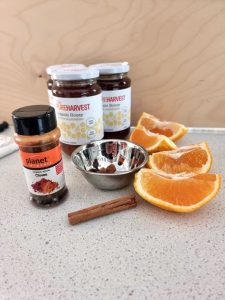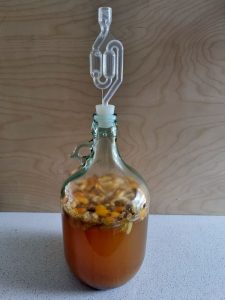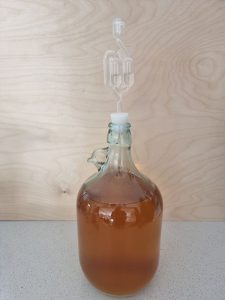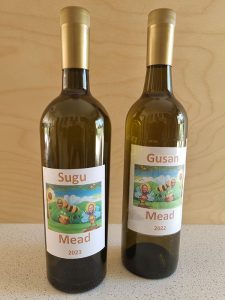Making mead (by Guy Palmer)
Guy Palmer, from Eltham, is this website’s webmaster and occasional author of food and drink articles.
Introduction
A few years ago, I (Guy) was lucky enough to attend a mead making course organised by the Eltham and District Winemakers Guild and even luckier to have Angela and Wayne Harridge as my tutors. During the course, I successfully made my first 5 litre batch of mead and, since then, have become a complete convert, mostly drinking mead in preference to wine. The material below is based on the extensive handouts from the course and I would like to thank Angela and Wayne for their permission to use them.
Mead is fermented honey, where the fermentation turns the sugars in the honey into alcohol. The end result is an alcoholic beverage which is an alternative to white wine but with its own unique taste.
Mead has a similar alcoholic strength to wine and is golden in colour. Unlike white wine, mead is generally drunk at room temperature and does not go off quickly after the bottle has been opened.
All meads are made with honey, yeast and water. Beyond that, ‘botanicals’ are often added for flavouring purposes, for example fruit or fruit juices (in which case the mead is called ‘melomel’) and/or spices or herbs (in which case the mead is called ‘metheglin’). Different varieties of honey, different strains of yeast, different botanicals and variations in the fermenting process can all result in different styles of mead.
How long it takes for the honey to ferment depends on the room temperature (fermentation rates increase with temperature) but the total process from start to bottling typical takes 8-12 weeks. But it doesn’t actually require much effort as most of the time is spent waiting for the fermentation to complete.
The recipe below is for a mead called ‘Joe’s ancient orange’ (JAO). Despite the name, it is a modern recipe which is easy to make as well as tasty.
1. Gather your suppliesAt the start, you will need:
Later on, you will need:
One local place where you can buy most of these supplies (plus the yeast) is Greensborough Home Brew Supplies, who are located at 29 Beewar Street, Greensborough. |
 |
2. Gather your ingredientsThese are the ingredients to make 5 litres of ‘Joe’s ancient orange’ (JAO):
|
 |
3. Prepare the ‘must’ (the mixture of the ingredients)Clean and sanitise all the equipment before use. Clean using hot water, avoiding detergents or other cleaning substances. Sanitise using a solution of 15 grams potassium metabisulphite (PMS) per litre of water. Pour 3.8 litres of water into the demijohn (DJ) and clearly mark the water level on the glass. Empty the water and do not erase the water level mark. Pour the 1.6Kg honey into the demijohn (it can be diluted using warm, <50degC water to make pouring easier). Add the cinnamon stick, cloves and raisins. Cut the orange into small pieces (so that they can easily be removed later on through the neck of the demijohn) and add them. Add water to the level of the 3.8 litre mark previously made. The water should be at around 20degC. Shake the mixture vigorously to get oxygen into it. Note: no more shaking or stirring from this point on! |
 |
4. Get the ferment startedHydrate the yeast (simple method).
Add the hydrated yeast to the demijohn. Fill the fermentation lock with water to the correct level (see marks on the airlock). Fit the fermentation lock and associated bung into the top of the demijohn. Keep the demijohn at a comfortable room temperature environment (20-25degC is ideal) until the fermentation has finished. |
 |
5. WaitThe ferment may take between 2 and 24 hours to start (bubbling from the airlock). The ferment should slow down within about 1 week depending on the ambient temperature. Once the ferment has slowed right down with minimal foaming, top up the demijohn with water until the mixture is around 3cm below the bung. Once you have done this, the fermentation rate will increase again –because the alcohol in the must has been diluted. Ensure that the fermentation lock is always clear of any blockages and that the water within the lock is clean. Wash out, clean and re-fill if and as necessary. Wait until fermentation is reasonably complete (say, 4-8 weeks), which is when there are fewer bubbles in the airlock than, say, one every 30 seconds (it doesn’t matter if you wait a bit longer). |
 |
6. RackSanitise all equipment using a solution of 15 grams potassium metabisulphite (PMS) per litre of water. Using tweezers or similar, remove all the orange pieces, raisins, cloves and cinnamon stick from the top of the demijohn (or leave them in until after the syphoning). Syphon the mead out into a temporary holding container. Remove all the gunk from the bottom of the demijohn and then wash and sanitise it. Pour the mead back into the demijohn. Add 0.1 grams of dissolved potassium metabisulphite (PMS) per litre of mead to inhibit oxidation and microbiological spoilage. Wait for a week or two for the mead to clear ready for bottling. |
 |
7. Fine tuneYou can add a bit of sugar either to balance excessive acidity/bitterness or just because you like sweet meads. You can also add acid to change the honey/fruit flavour, depending on your tastes. These are both important steps that can substantially change the taste for the better. Judging how much sugar and acid to add is done via experimentation on a sample. For sugar:
Following the test, add the appropriate amount of sugar to your mixture. For acid:
Following the test, add the appropriate amount of acid to your mixture. If you consider yourself an expert, you can also potentially add some tannins (typical rates 0.01 to 0.1 grams/litre). If your mead is overly cloudy, you can try ‘fining it’ (adding a product to remove an offending substance from the mead). Read more. |

|
8. BottleSanitise all the equipment using a solution of 15 grams potassium metabisulphite (PMS) per litre of water. Syphon the mead out into a temporary holding container, wash out the now empty demijohn, and then pour the mead back into the demijohn. Add 0.1 grams of dissolved potassium metabisulphite (PMS) per litre of mead to your final mixture to inhibit oxidation and microbiological spoilage. Add 0.1 grams dissolved potassium sorbate per litre of mead to kill off any remaining yeast. Wait a few days. Fill the bottles. With wastage, you should be able to get 5 or 6 bottles of 750ml mead. If you are a little short on the last bottle, you can add some white wine (or just drink it straightaway!). Cap (e.g. using NovaTwist caps). |
 |
9. Wait then drinkAlthough you can drink it straightaway, mead tastes better the longer it is aged. |

